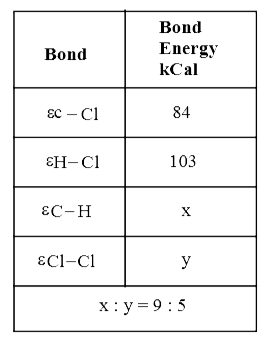Ethyl chloride (C2H5Cl), is prepared by reaction of ethylene with hydrogen chloride :
C2H4(g)+HCl(g)→C2H5cl(g) ΔH=−72.3kJ
What is the value of ΔE (in kJ), if 70 g of ethylene and 73 g of HCL are allowed to react at 300 K.
−69.8
−180.75
−174.5
−139.6
The correct Answer is:D
To find the value of ΔE for the reaction of ethylene (C2H4) with hydrogen chloride (HCl) to produce ethyl chloride (C2H5Cl), we can follow these steps:
Step 1: Calculate the number of moles of ethylene and hydrogen chloride.
1. Given mass of ethylene (C2H4) = 70 g
- Molar mass of C2H4 = 2(12) + 4(1) = 28 g/mol
- Number of moles of C2H4 = mass / molar mass = 70 g / 28 g/mol = 2.5 moles
2. Given mass of hydrogen chloride (HCl) = 73 g
- Molar mass of HCl = 1 + 35.5 = 36.5 g/mol
- Number of moles of HCl = mass / molar mass = 73 g / 36.5 g/mol = 2 moles
Step 2: Identify the limiting reagent.
- The balanced reaction is:
C2H4(g)+HCl(g)→C2H5Cl(g)
- From the stoichiometry of the reaction, 1 mole of C2H4 reacts with 1 mole of HCl.
- We have 2.5 moles of C2H4 and 2 moles of HCl. Since HCl is present in a lesser amount, it is the limiting reagent.
Step 3: Calculate the change in the number of moles of gas (ΔNg).
- Reactants: 1 mole of C2H4 + 1 mole of HCl = 2 moles of reactants
- Products: 1 mole of C2H5Cl = 1 mole of products
- ΔNg = moles of products - moles of reactants = 1 - 2 = -1
Step 4: Use the relationship between ΔH and ΔE.
- The relationship is given by:
ΔH=ΔE+ΔNg⋅R⋅T
- Given ΔH = -72.3 kJ, R = 8.314 J/(mol·K) = 0.008314 kJ/(mol·K), and T = 300 K.
Step 5: Substitute values into the equation.
- Substitute ΔH, ΔNg, R, and T into the equation:
−72.3=ΔE+(−1)⋅(0.008314)⋅(300)
- Calculate the term involving R and T:
−72.3=ΔE−2.4942
- Rearranging gives:
ΔE=−72.3+2.4942=−69.8058 kJ
Step 6: Finalize the answer.
- Since we are looking for ΔE for the reaction involving 2 moles of HCl (as it is the limiting reagent), we multiply by 2:
ΔE for 2 moles=−69.8058×2=−139.6116 kJ
- Rounding gives:
ΔE≈−139.6 kJ
Final Answer:
ΔE≈−139.6 kJ
---
1. Given mass of ethylene (C2H4) = 70 g
- Molar mass of C2H4 = 2(12) + 4(1) = 28 g/mol
- Number of moles of C2H4 = mass / molar mass = 70 g / 28 g/mol = 2.5 moles
- Molar mass of HCl = 1 + 35.5 = 36.5 g/mol
- Number of moles of HCl = mass / molar mass = 73 g / 36.5 g/mol = 2 moles
- The balanced reaction is:
C2H4(g)+HCl(g)→C2H5Cl(g)
- From the stoichiometry of the reaction, 1 mole of C2H4 reacts with 1 mole of HCl.
- We have 2.5 moles of C2H4 and 2 moles of HCl. Since HCl is present in a lesser amount, it is the limiting reagent.
- Reactants: 1 mole of C2H4 + 1 mole of HCl = 2 moles of reactants
- Products: 1 mole of C2H5Cl = 1 mole of products
- ΔNg = moles of products - moles of reactants = 1 - 2 = -1
- The relationship is given by:
ΔH=ΔE+ΔNg⋅R⋅T
- Given ΔH = -72.3 kJ, R = 8.314 J/(mol·K) = 0.008314 kJ/(mol·K), and T = 300 K.
- Substitute ΔH, ΔNg, R, and T into the equation:
−72.3=ΔE+(−1)⋅(0.008314)⋅(300)
- Calculate the term involving R and T:
−72.3=ΔE−2.4942
- Rearranging gives:
ΔE=−72.3+2.4942=−69.8058 kJ
- Since we are looking for ΔE for the reaction involving 2 moles of HCl (as it is the limiting reagent), we multiply by 2:
ΔE for 2 moles=−69.8058×2=−139.6116 kJ
- Rounding gives:
ΔE≈−139.6 kJ
ΔE≈−139.6 kJ
Topper's Solved these Questions
- BOOK - MOTIONCHAPTER - THERMODYNAMICSEXERCISE - EXERCISE - 2 (LEVEL-II)6videos
THERMODYNAMICS
- BOOK - MOTIONCHAPTER - THERMODYNAMICSEXERCISE - EXERCISE - 2 (LEVEL-II ASSERTION REASON)6videos
THERMODYNAMICS
- BOOK - MOTIONCHAPTER - THERMODYNAMICSEXERCISE - EXERCISE - 133videos
THERMODYNAMICS
- BOOK - MOTIONCHAPTER - THERMOCHEMISTRY EXERCISE - Exercise - 4 Level-II8videos
THERMOCHEMISTRY
Similar Questions
Knowledge Check
- Question 1 - Select One
Ethyl chloride (C2H5Cl) , is prepared by reaction of ethylene with hydrogen chloride:
C2H4(g)+HCl(g)→C2H5Cl(g)
ΔH=−72.3kJ/mol
What is the value of ΔE( in kJ), if 98g of ethylene and 109.5g of HCl are allowed to react at 300KA−64.81B−190.71C−209.41D−224.38 - Question 2 - Select One
Ethyl chloride (C2H5Cl) , is prepared by reaction of ethylene with hydrogen chloride:
C2H4(g)+HCl(g)→C2H5Cl(g) ΔH=−72.3KJ/mol
What is the value of ΔE(in KJ), if 98 g fo ethylene and 109.5 g if HCl are allowed to react at 300KA−64.81B−190.71C−209.41D−229.38 - Question 3 - Select One
Ethyl choride (C2H4(g)Cl), is prepared byt reaction of ethylen with hydrogen chloride :
C2H4(g)+HCl→C2H5Cl(g)
What is the value of ΔU (in kJ), if 70 g ethlene and 73 g of HCl are allowed to react at 300 K.A−69.8B−180.75C−174.5D−139.6
H2(g)+Cl2=2HCl(g),ΔH(298K)=−92.01kJ.
For this reaction ΔU is equal toView SolutionIn the reaction , CO2(g)+H2(g)→CO(g)+H2O(g), ΔH=2.8kJ,ΔH represents
View SolutionIn the reaction
CO2(g)+H2(g)→CO(g)+H2O(g),
ΔH=2.8kJ
ΔH representsView SolutionIn the reaction,
CO2(g)=H2(g)→CO(g)=H2O(g), ΔH=2.8kJ
ΔH represents :View SolutionThe reaction CH4(g)+Cl2(g)→CH3Cl(g)→HCl(g) has ΔH=−25kCal .

From the given data , what is the bond energy of Cl – Cl bondView Solution

